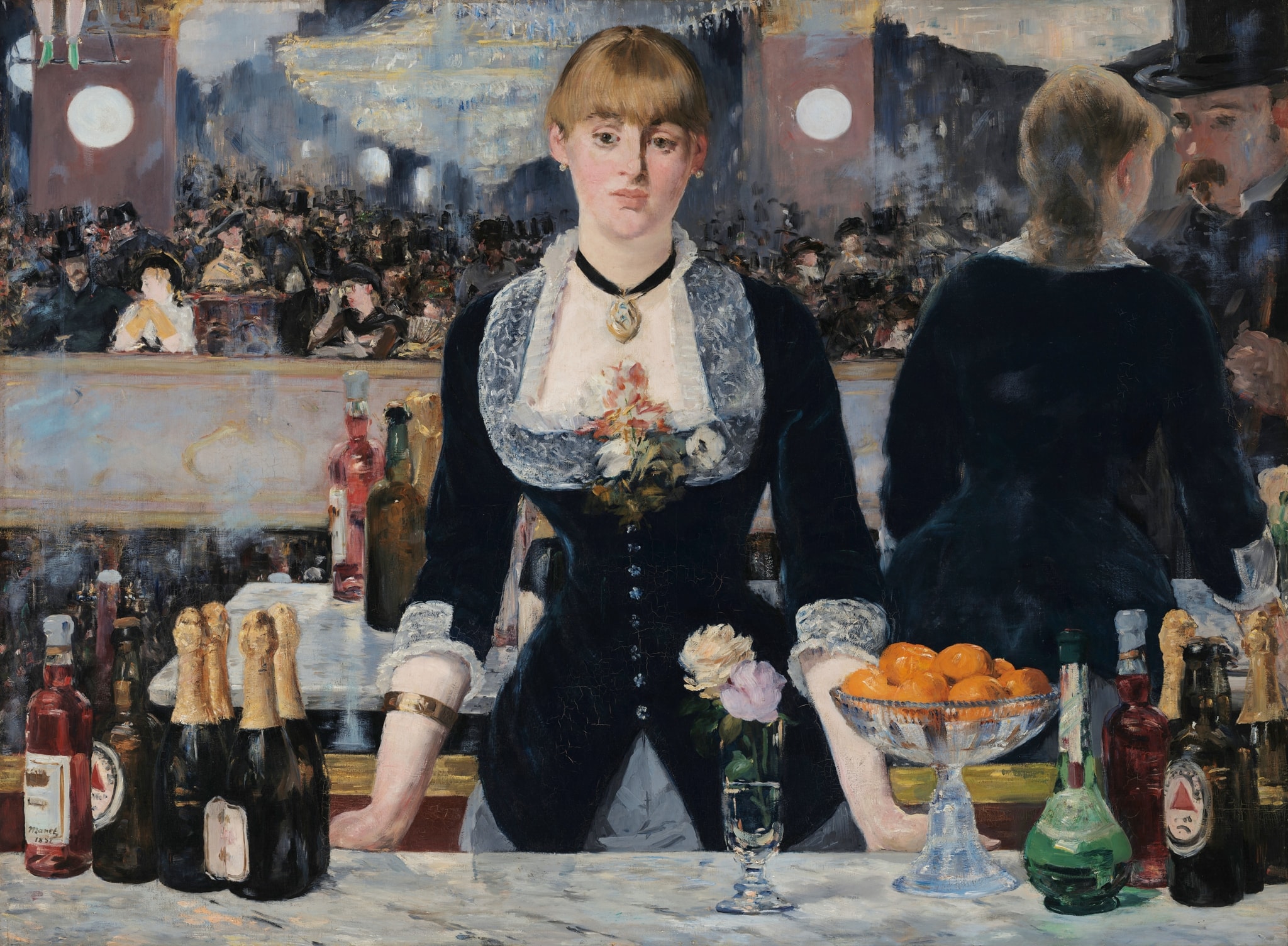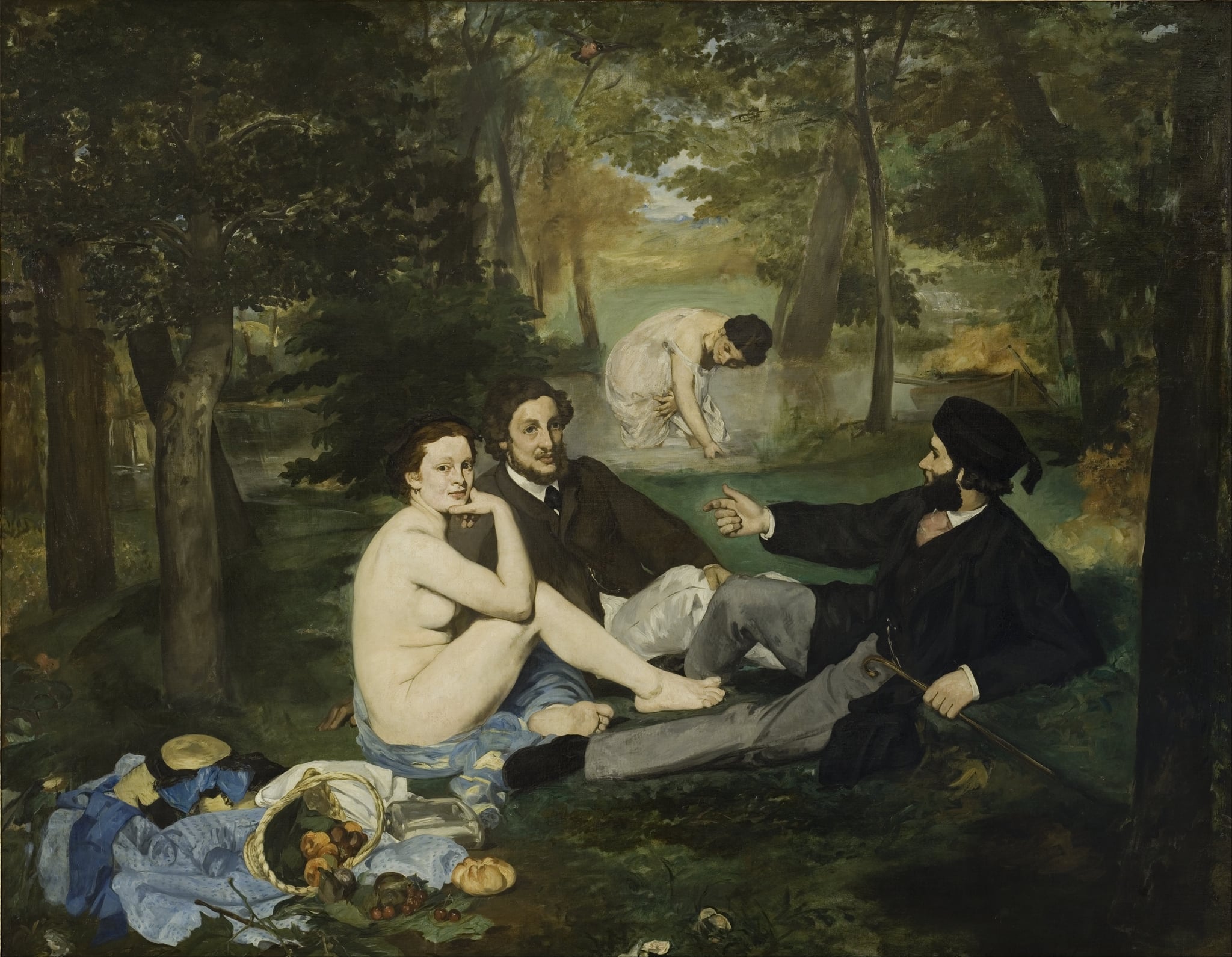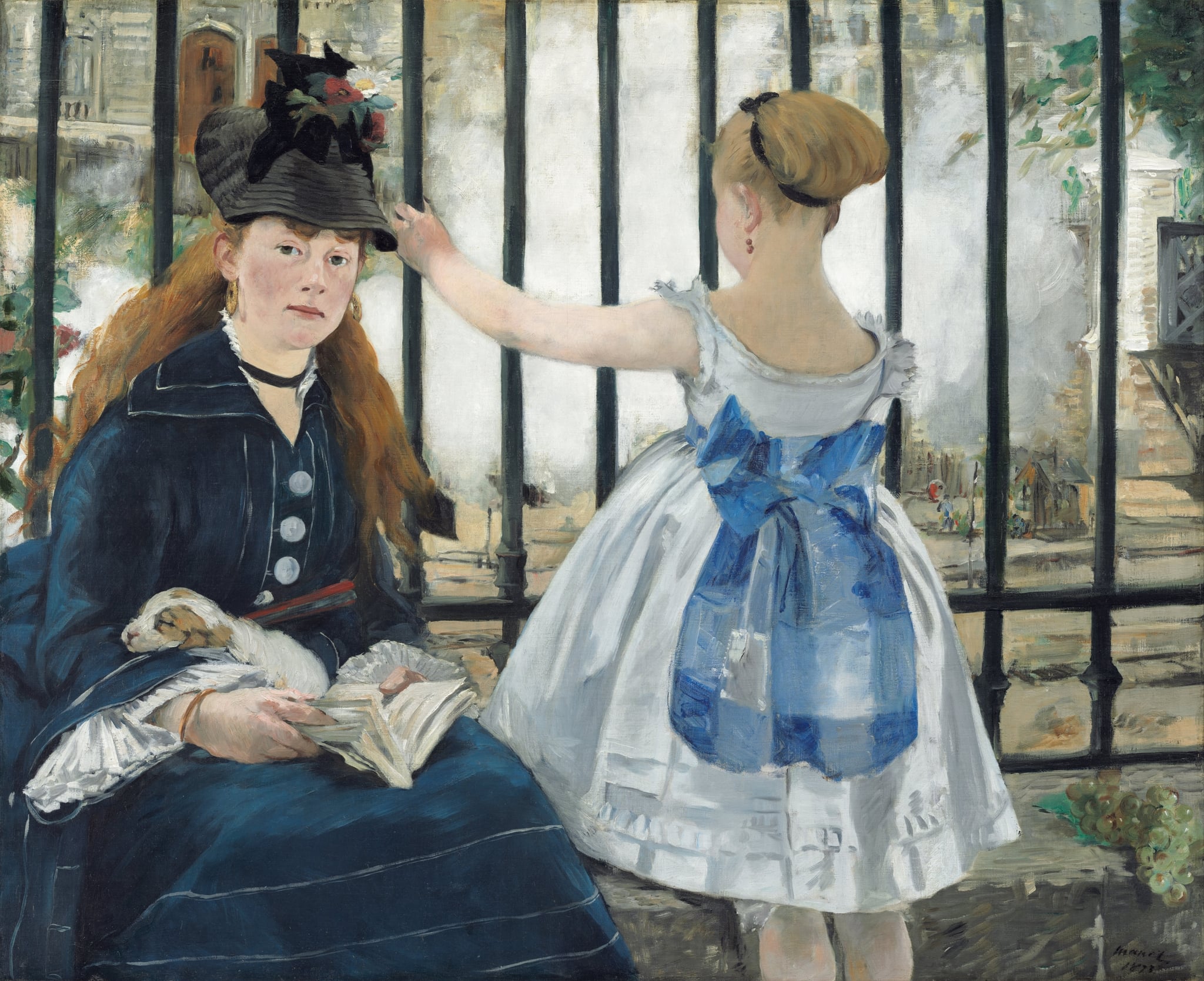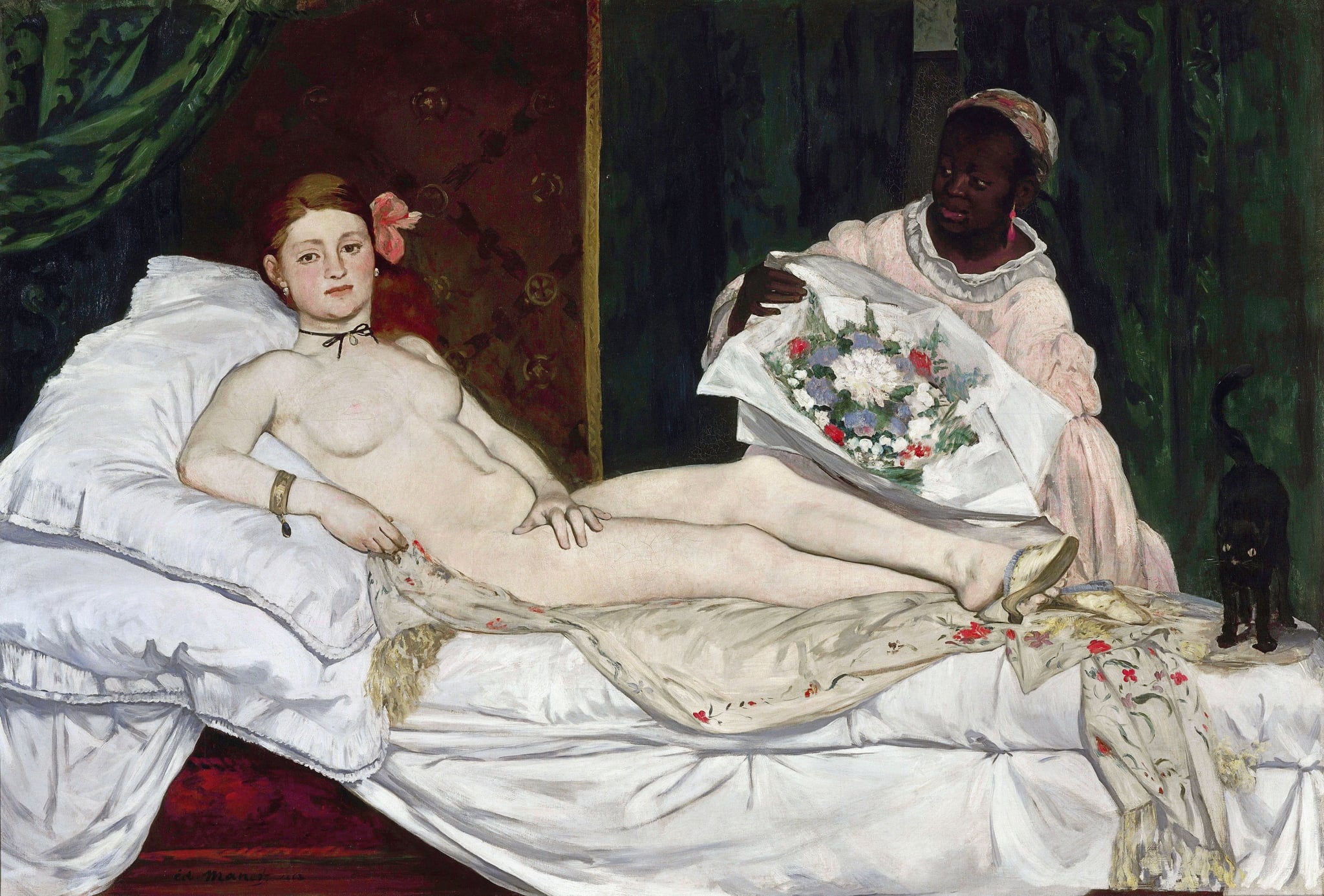A Bar at the Folies-Bergère
Fast Facts
- Year
- 1882
- Medium
- Oil on canvas
- Dimensions
- 96 × 130 cm
- Location
- The Courtauld Gallery, London

Click on any numbered symbol to learn more about its meaning
Meaning & Symbolism
The meaning of A Bar at the Folies-Bergère lies in how its mirror and commodities turn a bustling music hall into a meditation on modern desire and the commodification of people. Manet positions the barmaid as both vendor and object, framed by logos and luxury goods that implicate the viewer in urban exchange 3. The skewed reflection—where the man appears only in the mirror and the barmaid’s double shifts right—makes the act of looking itself unstable yet deliberately constructed from an oblique vantage 4. Why A Bar at the Folies-Bergère is important: it crystallizes the late 19th‑century city as a field of spectatorship, branding, and fractured identity, becoming Manet’s culminating statement on the painter of modern life 2.
Manet builds a theater of modernity in the rectangle of the bar. The frontally posed barmaid—identified as Suzon, who modeled for Manet in a studio mock‑up—meets us with a steady, unreadable gaze, yet everything around her converts that gaze into a market transaction: chilled champagne, liqueurs, the crisp glass vase, and a heap of oranges rendered as bright, tangible currency 12. The labels with red triangles on the beer bottles advertise Bass Pale Ale, the United Kingdom’s first registered trademark, inserting a globally recognized commercial sign directly into the picture plane 7. Manet’s strategic rhyme doubles the branding on the bottles with the barmaid’s red triangular corsage, tying human presence to commodity display through a formal echo that makes identity feel logo-like 5. Electric globes flare across the mirrored background and chandeliers dissolve into daubs of silvery light, signaling the new illumination technologies that powered the café‑concert’s spectacle and its brisk, anonymous pleasures 2. Even the cropped legs of a trapeze artist at upper left insist that we are inside a machine for entertainment, where bodies, like beverages, circulate for purchase and consumption 12. The mirror is the work’s decisive modern device. Rather than an error, the displaced reflection and the man visible only in the glass result from Manet’s adoption of an oblique viewpoint, reconstructable from the painting’s perspectival cues 4. That choice converts the mirror into a critical tool: by refusing a single, centered truth, Manet exposes how urban life produces multiple, misaligned reflections of the self. The barmaid stands as the nodal point of these fractured relations. In front, she is self-contained, almost impassive; behind, her reflected figure tilts toward a mustachioed customer, insinuating a transaction that the frontal figure withholds. This split registers the double bind of her role—both salesperson and potential commodity—an insight that underpins social-historical readings of the painting’s capitalist modernity 3. The countertop is thus more than still life; it is an index of desire’s pricing. Oranges—elsewhere in Manet associated by some scholars with sexual commerce—sit heaped in a cut-glass bowl, while the neat ranks of champagne and cordials standardize pleasure into recognizable brands and prices 3. Manet’s paint handling reinforces this argument. The barmaid’s black dress and pale skin are modeled with cool restraint, while the surrounding scene dissolves into flicker—brushmarks that mimic the quick, distracted looking of a crowd. The signature placed on a bottle folds authorship into commodity and commodity into spectacle, reminding us that the painting itself participates in the marketplace it depicts 23. Yet the effect is not cynicism alone. By staging our encounter at arm’s length—our hands almost resting where hers brace the marble—Manet entangles us in the ethics of spectatorship. We are the addressees whose money, gaze, and desires animate this scene. The painting’s brilliance is to make that complicity visible without resolving it: the mirror both reveals and misdirects, the brands both identify and erase, the woman both meets our look and withholds herself. In that unresolved tension, A Bar at the Folies-Bergère becomes a keystone of modern art: a picture that turns looking into a problem and the city into a reflexive system of images, goods, and roles 234.Citations
- Courtauld Gallery, Collection Online: A Bar at the Folies-Bergère (P.1934.SC.234)
- Encyclopaedia Britannica: A Bar at the Folies-Bergère
- Twelve Views of Manet’s “Bar” (Princeton University Press)
- Thierry de Duve, Intentionality and Art Historical Methodology: A Case Study (nonsite.org)
- BBC Culture, Kelly Grovier: A symbol planted in cleavage
- The Met, Heilbrunn Timeline of Art History: Édouard Manet (Rebecca Rabinow)
- Bass Brewery (UK trademark context): Red triangle
Explore Deeper with AI
Ask questions about A Bar at the Folies-Bergère
Popular questions:
Powered by AI • Get instant insights about this artwork
Interpretations
Historical Context
Source: Courtauld Gallery; Encyclopaedia Britannica; Bass Brewery (UK trademark record)
Formal Analysis
Source: Thierry de Duve (nonsite.org); Encyclopaedia Britannica; BBC Culture (Kelly Grovier)
Symbolic Reading
Source: Twelve Views of Manet’s “Bar” (Princeton University Press); Courtauld Gallery; BBC Culture (Kelly Grovier)
Social Commentary
Source: Twelve Views of Manet’s “Bar” (Princeton University Press); Encyclopaedia Britannica
Biographical
Source: The Met, Heilbrunn Timeline (Rebecca Rabinow); Courtauld Gallery; Encyclopaedia Britannica
Reception History
Source: Princeton University Press (Twelve Views of Manet’s “Bar”); Thierry de Duve (nonsite.org); Encyclopaedia Britannica
Related Themes
About Édouard Manet
More by Édouard Manet

Luncheon on the Grass
Édouard Manet (1863)
Luncheon on the Grass stages a confrontation between <strong>modern Parisian leisure</strong> and <strong>classical precedent</strong>. A nude woman meets our gaze beside two clothed men, while a distant bather and an overturned picnic puncture naturalistic illusion. Manet’s scale and flat, studio-like light convert a park picnic into a manifesto of <strong>modern painting</strong> <sup>[1]</sup><sup>[2]</sup>.

The Railway
Édouard Manet (1873)
Manet’s The Railway is a charged tableau of <strong>modern life</strong>: a composed woman confronts us while a child, bright in <strong>white and blue</strong>, peers through the iron fence toward a cloud of <strong>steam</strong>. The image turns a casual pause at the Gare Saint‑Lazare into a meditation on <strong>spectatorship, separation, and change</strong> <sup>[1]</sup><sup>[3]</sup>.

Olympia
Édouard Manet (1863 (Salon 1865))
A defiantly contemporary nude confronts the viewer with a steady gaze and a guarded pose, framed by crisp light and luxury trappings. In Olympia, <strong>Édouard Manet</strong> strips myth from the female nude to expose the <strong>modern economy of desire</strong>, power, and looking <sup>[1]</sup><sup>[3]</sup>.